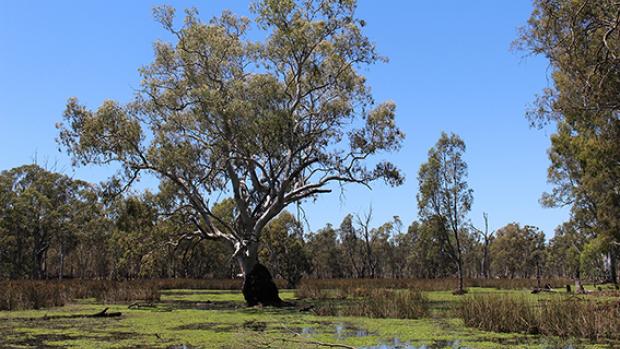Loading
Protecting our magic lagoon

Reedy Lagoon is an oasis for more than just the endangered plants and animals that rely on it to survive.
It’s a place loved by the local community and popular with tourists. It’s important to Traditional Owners and, on any given day, really is spectacular.
“Reedy is one of our magic little spots in the forest that’s valued by locals and visitors,” local dairy farmer and Gunbower Island Community Reference Group member Jodie Hay said.
And in dry times, it becomes even more important.
“Reedy Lagoon is in really good condition because of the work done over the previous decades,” Victorian Environmental Water Holder Chairperson Denis Flett said.
“It is one of the very few permanent wetlands in the mid Murray region that is still in good condition.
“It was one of the only wetlands to receive water during the Millennium Drought and it has been managed with water for the environment for the past 15 years. That’s how important it is.”
This year, more animals and plants are relying on it staying healthy.
“Reedy Lagoon is important locally because it is critical habitat for endangered species and provides a seed source for the Murray River,” North Central Catchment Management Authority Program Delivery Executive Manager Tim Shanahan said.
“There aren’t too many permanent wetlands in the region, especially with the drought in NSW. And those that are permanent are likely to be irrigation or recreation storages, which generally offer poorer quality habitat for waterbirds.
“A lot of waterbirds bred in the forest and in Reedy Lagoon last year, and the area is also a hotspot for waterbirds coming south escaping the dry.”
This year, the wetland has drawn down quickly on the back of one of the hottest summers on record, and it is time for a drink.
“The wetland will be topped up, so it can continue to be an important refuge for the region,” Mr Shanahan said.
“At least 600 megalitres will be needed to ensure it stays healthy.
“The water will start to flow in late May, outside of irrigation season. The regulator is fitted with a carp screen, which stops adult carp entering the wetland in an effort to reduce impacts from carp on the aquatic plants.
“Importantly, this is not the forest. It is a permanent lagoon. Many floodplains have permanent lagoons that sustain native birds and animals such as emus, kangaroos, snakes and all kinds of bugs and small mammals and animals, and Reedy Lagoon is no exception.”
“Delivering water for the environment to Reedy Lagoon will ensure the habitat is maintained for species that inhabit the wetland and provide refuge for other animals that live in the forest,” Mrs Hay said.
VEWH Chair Denis Flett said the lagoon was an important local, state and national wetland, and its future needed to be protected.
“Environmental water can’t be used for any other purpose – it is water legally set aside for the environment to help cover the gap between natural flows and current flows under a regulated system,” he said.
The VEWH is currently reviewing plans for 2019-20 to give a much-needed drink to two other semi-permanent wetlands in Gunbower Forest to ensure that, if dry conditions continue, enough high-quality habitat is available to support waterbirds and other wetland-dependent animals.
The Gunbower Forest Flooding for Life project is delivered by the North Central CMA in partnership with Goulburn–Murray Water, Murray-Darling Basin Authority, the Commonwealth Environmental Water Office, the Victorian Environmental Water Holder, DELWP and Parks Victoria.
It is part of The Living Murray program, a joint initiative of the New South Wales, Victorian, South Australian, Australian Capital Territory and the Commonwealth governments, coordinated by the MDBA.
